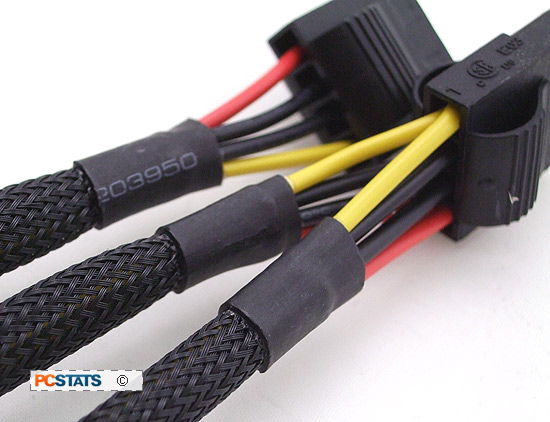All cables from the Seasonic X-460 Fanless are wrapped in black
wire loom sleeves, the ends are zip tied and covered with heat
shrink tubing. The main ATX power connector is ~60cm long, the other cables
vary from 60cm to 65cm in length to the first connector on the daisy
chain.

Plugging the modular cables
into the Seasonic X-460 is easy. The connectors themselves are secured by a
plastic retention tab that notches inside the modular cavity. In certain system cases attaching and
detaching cables can become an issue since there won't be much room to grip them
with your hands.

The cable count adds
up to two SATA power cables (five power connectors total), two molex
power cables (five power connectors total), one PCI Express power cable
(twor connectors, each can be used with eight or six pins), a single motherboard cable,
one CPU cable (either 8-pin or two 4-pin) and a molex to two FDD power
converter.
Polymer Aluminum Capacitors
Inside
The Seasonic X460 Fanless power supply supports over/under voltage, over current, over power and short circuit
protection in order to protect you, the power supply and
the PC system from damage. The X-460 Fanless is designed to operate
in temperatures between 0-50 degrees Celsius and in relative humidity between 20-80%. The power supply is
fully 100-240VAC, 50/60Hz compliant (max 90-264VAC) so it can be used anywhere
in the world. The fuse is not user replaceable.

The first thing that's immediately obvious
upon opening Seasonic's 80 Plus Gold rated X-460
Fanless power supply is the total lack of internal wiring. This puppy is just cleanly laid out
with plenty of space between components for good airflow. The circuit boards are
all dual layer PCB and Seasonic use solid state polymer aluminum capacitors and Japanese made 105 Celsius
Grade 'A' rated electrolytic caps for the power filter (larger, brown wrapping). The main 120V
power socket (pictured at upper right) is fully RF shielded too.

Another interesting innovation with the X-460 Fanless is
the circuit board where all the modular cables connect. It's actually the
DC-to-DC converter - basically the circuit that takes the main DC supply and breaks it off
to the different voltage levels required by the various power
cables that hook up to the motherboard. An aluminum heatspreader covers the
power MOSFETs that form part of the +3.3V and +5V voltage regulator on that daughterboard.
Finally, it's time
for the power supply load tests and final thoughts on this fanless PSU.
